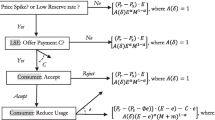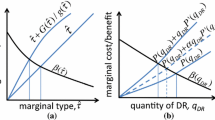Abstract
This paper presents an analysis of competition between generators when incentive-based demand response is employed in an electricity market. Thermal and hydropower generation are considered in the model. A smooth inverse demand function is designed using a sigmoid and two linear functions for modeling the consumer preferences under incentive-based demand response program. Generators compete to sell energy bilaterally to consumers and system operator provides transmission and arbitrage services. The profit of each agent is posed as an optimization problem, then the competition result is found by solving simultaneously Karush– Kuhn–Tucker conditions for all generators. A Nash–Cournot equilibrium is found when the system operates normally and at peak demand times when DR is required. Under this model, results show that DR diminishes the energy consumption at peak periods, shifts the power requirement to off-peak times and improves the net consumer surplus due to incentives received for participating in DR program. However, the generators decrease their profit due to the reduction of traded energy and market prices.










Similar content being viewed by others
References
Aketi, P., Sen, S.: Modeling demand response and economic impact of advanced and smart metering. Energy Syst. 5(3), 583–606 (2014)
Albadi, M.H., El-Saadany, E.F.: A summary of demand response in electricity markets. Electr. Power Syst. Res. 78(11), 1989–1996 (2008)
Antunes, P., Faria, P., Vale, Z.: Consumers performance evaluation of the participation in demand response programs using baseline methods. In: 2013 IEEE Grenoble Conference 2011, pp. 1–6 (2013)
Bloustein, E.: Assessment of customer response to real time pricing. Rutgers-The State University of New Jersey, Tech. Rep, pp. 1–23 (2005)
Chen, Y., Lin, W.S., Han, F., Yang, Y.H., Safar, Z., Liu, K.J.R.: A cheat-proof game theoretic demand response scheme for smart grids. In: IEEE International Conference on Communications, pp. 3362–3366 (2012)
Cunningham, L.B., Baldick, R., Baughman, M.L.: An empirical study of applied game theory: transmission constrained cournout behaviour. IEEE Trans. Power Syst. 17(1), 166–172 (2002)
Deng, R., Yang, Z., Chow, M.-Y., Chen, J.: A survey on demand response in smart grids: mathematical models and approaches. IEEE Trans. Ind. Inform. 11(3), 1–1 (2015)
Diaz, C., Ruiz, F., Patino, D.: Modeling and control of water booster pressure systems as flexible loads for demand response. Appl. Energy 204, 106–116 (2017)
Fahrioglu, M., Alvarado, F.L.: Designing incentive compatible contracts for effective demand management. IEEE Trans. Power Syst. 15(4), 1255–1260 (2000)
Faria, P., Vale, Z., Antunes, P.: Determining the adjustment baseline parameters to define an accurate customer baseline load. In: IEEE Power and Energy Society General Meeting 2011 (2013)
Forouzandehmehr, N., Han, Z., Zheng, R.: Stochastic dynamic game between hydropower plant and thermal power plant in smart grid networks. IEEE Syst. J. 10(1), 88–96 (2014)
Gabriel, S.A., Conejo, A.J., Fuller, J.D., Hobbs, B.F., Ruiz, C.: Complementarity Modeling in Energy Markets, vol. 1. Springer, New York (2013)
Garcia, A., Campos-Nañez, E., Reitzes, J.: Dynamic pricing and learning in electricity markets. Oper. Res. 53(2), 231–241 (2005)
Genc, T.S., Thille, H.: Dynamic Competition in Electricity Markets: Hydropower and Thermal Generation. In: The Economics of Energy Markets (2008)
Madaeni, S.H., Sioshansi, R.: The impacts of stochastic programming and demand response on wind integration. Energy Syst. 4(2), 109–124 (2013)
Mas-Colell, A., Whinston, M.D., Green, J.R.: Microeconomic Theory. Oxford student edition. Oxford University Press, Oxford (1995)
Mohajeryami, S., Doostan, M., Schwarz, P.: The impact of customer baseline load (CBL) calculation methods on peak time rebate program offered to residential customers. Electr. Power Syst. Res. 137, 59–65 (2016a)
Mohajeryami, S., Doostan, M., Schwarz, P.: The impact of customer baseline load (CBL) calculation methods on peak time rebate program offered to residential customers. Electr. Power Syst. Res. 137(October), 59–65 (2016b)
Osborne, M.J.: A course in game theory, 1st edn. MIT Press, London (1995)
Chao, H.: Demand response in wholesale electricity markets: the choice of customer baseline. J. Regul. Econ. 39(1), 68–88 (2011)
Severin, B.: Peak-Time Rebates: Money for Nothing? (2014). http://www.greentechmedia.com/articles/read/Peak-Time-Rebates-Money-for-Nothing
Samadi, P., Mohsenian-Rad, H., Schober, R., Wong, V.W.S.: Advanced demand side management for the future smart grid using mechanism design. IEEE Trans. Smart Grid 3(3), 1170–1180 (2012)
Siano, P.: Demand response and smart grids—a survey. Renew. Sustain. Energy Rev. 30, 461–478 (2014)
Su, C.L., Kirschen, D.: Quantifying the effect of demand response on electricity markets. IEEE Trans. Power Syst. 24(3), 1199–1207 (2009)
Tirole, J.: The Theory of Industrial Organization. MIT Press, Cambridge (1988)
Vardakas, J.S., Zorba, N., Verikoukis, C.V.: A survey on demand response programs in smart grids: pricing methods and optimization algorithms. IEEE Commun. Surv. Tutor. 17(1), 152–178 (2015)
Varian, H.: Microeconomics Analysis, 3rd edn. Norton & Company, New York (1992)
Vega Redondo, F.: Economics and the theory of Games. Cambridge University Press, Cambridge (2003)
Villar, J., Rudnick, H.: Hydrothermal market simulator using game theory: assessment of market power. IEEE Trans. Power Syst. 18(1), 91–98 (2003)
Vuelvas, J., Ruiz, F.: Demand response: understanding the rational behavior of consumers in a peak time rebate program. In: Automatic Control (CCAC), 2015 IEEE 2nd Colombian Conference, pp. 1–6 (2015)
Vuelvas, J., Ruiz, F.: Rational consumer decisions in a peak time rebate program. Electr. Power Syst. Res. 143, 533–543 (2017)
Wijaya, T.K., Vasirani, M., Aberer, K.: When bias matters: an economic assessment of demand response baselines for residential customers. IEEE Trans. Smart Grid 5(4), 1755–1763 (2014)
Zhu, Q., Sauer, P., Basar, T.: Value of demand response in the smart grid. In: 2013 IEEE Power and Energy Conference at Illinois, PECI 2013, pp. 76–82 (2013)
Acknowledgements
J. Vuelvas received a doctoral scholarship from COLCIENCIAS (Call 647-2014). This work has been partially supported by COLCIENCIAS (Grant 1203-669-4538, Acceso Universal a la Electricidad) and by Pontificia Universidad Javeriana (Grant ID 006486).
Author information
Authors and Affiliations
Corresponding author
Rights and permissions
About this article
Cite this article
Vuelvas, J., Ruiz, F. A novel incentive-based demand response model for Cournot competition in electricity markets. Energy Syst 10, 95–112 (2019). https://doi.org/10.1007/s12667-018-0271-2
Received:
Accepted:
Published:
Issue Date:
DOI: https://doi.org/10.1007/s12667-018-0271-2




